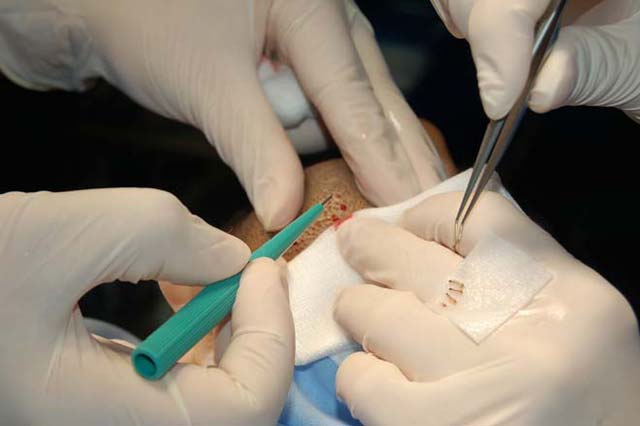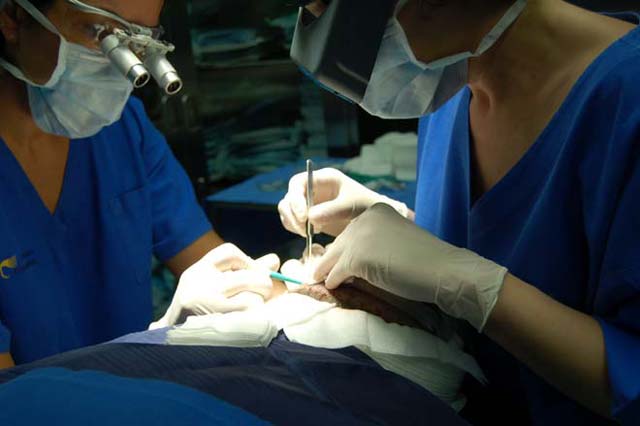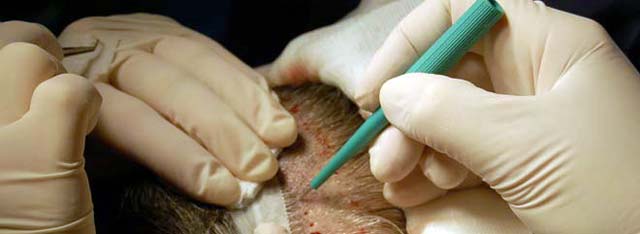In recent years the FUE method – follicular unit extraction – has been gaining more and more widespread popularity. It consists of collecting single follicular units, leaving microscopic, undetectable to the naked eye, minute scars in donor areas. In this method all the vital structures of the hair are transplanted including stem cells, responsible for its growth.
Indications
Typically the FUE hair transplant procedure is performed in young patients who wish to avoid scarring in donor area. Such approach allows for very short crew cut. Frequently a FUE procedure is carried out in corrections of minor hair loss (receding hairline, eyebrows or moustache) and scars – also subsequently to hair transplant procedures performed with the classic method. Also, the FUE method is of particular use in patients with inelastic scalp as well as in those with a tendency to hypertrophic massive scars. The FUE method may also be used in correcting larger areas of alopecia although it may be necessary to spread the procedure over several sessions. Patients in whom this procedure is most preferably carried out have straight dark hair, and it is preferable if the hair is quite dense. The FUE method lends itself very well to collecting hair from other body areas such as beard, torso or pubic area. (Photo 3)

FUE graft collection from chin area
Preparation for procedure
Just as prior to a classic hair transplant procedure recommended tests should be done. Within two weeks before the procedure aspirin or drugs containing acetylsalicylic acid should not be administered. If a thickening procedure is planned it is recommended to apply 5% Loxon (Regaine 5%) at least once daily for two months prior to procedure. On the day before procedure neither strong coffee nor alcohol should be drunk. There is no need to grow longer hair before procedure. However, it is advisable to bring to the clinic a cap (best with a visor like a baseball cap, not a tight woolen hat). At consultation the surgeon may give a different set of recommendations, which should be observed.
Procedure
FUE hair transplant procedure is carried out under local anesthesia. Its detailed plan is presented to the patient at initial consultation. Prior to procedure the surgeon selects areas from which grafts will be collected (donor areas) and areas where grafts will be inserted (recipient areas).For the purposes of medical documentation photos are taken. The surgeon may evaluate hair density using a video microscope or Trichoscan.

Team collects grafts using FUE method
Donor area is shaved as this enhances the precision of the procedure. For graft collection the patient lies on his belly. Patience is of paramount importance as this stage of procedure lasts from 2 to 4 hours. (Photo 1). The surgeon and his assistant collect individual follicular units with a special surgical instruments (Photo 2). There is always a probability that due to specific hair growth pattern the graft collecting procedure using FUE method may not be carried out. What then remains is to collect grafts using the classic strip method. Such a change is possible only with the patient’s consent.

FUE graft collection requires tremendous precision
The collected grafts are inserted in microscopic incisions. For many years Klinika Kolasinski has been using a special technique called four hands stick and place, which allows for a rapid and precise placement of grafts in recipient area. That is possible to place maximum 3000 grafts during one session but such operation takes 10 to 12 hours. So usually this procedure is carry out two or free smaller sessions day by day.
After the procedure the head remains without any dressing. In some cases the surgeon may decide to apply a dressing on the first day postoperatively. Usually the patient can leave the clinic immediately after procedure. In some cases, however, he may have to stay in the clinic for a day.
Post-operative
The period of recovery is very short. Donor area usually takes 1-2 weeks to heal. During that period collection sites heal and become invisible. Regrowing hair in that area helps camouflage small scars. The FUE method makes it possible to have short hair without a worry about traces of surgical intervention.
Donor area heals just as quickly. For the first couple of days postoperatively precaution must be taken so as not to damage the grafts. Hair is washed three days postoperatively. As an appropriate anesthesia is applied, usually there is no swelling of the forehead. Little scabs covering grafts disappear within a week, and the transplanted hair goes through telogen phase, falling out within two weeks. New hair grows back after three months. Patients usually make a full recovery within one to two weeks and therefore can normally work. Also sporting activities can be undertaken one week postoperatively. The FUE hair transplant method does not necessitate any follow-up visits or suture removal.
Advantages of fue method
- Scars invisible at donor sites
- Possibility of wearing close cropped hair
- Method can be used in patients with a tendency to massive hypertrophic scars
- Possibility of correcting scars in the scalp
- Full quick recovery
- No need of follow-up visits
Disadvantages of fue method
- Considerably longer duration of procedure
- Higher cost
- Not possible in patients with very curly hair